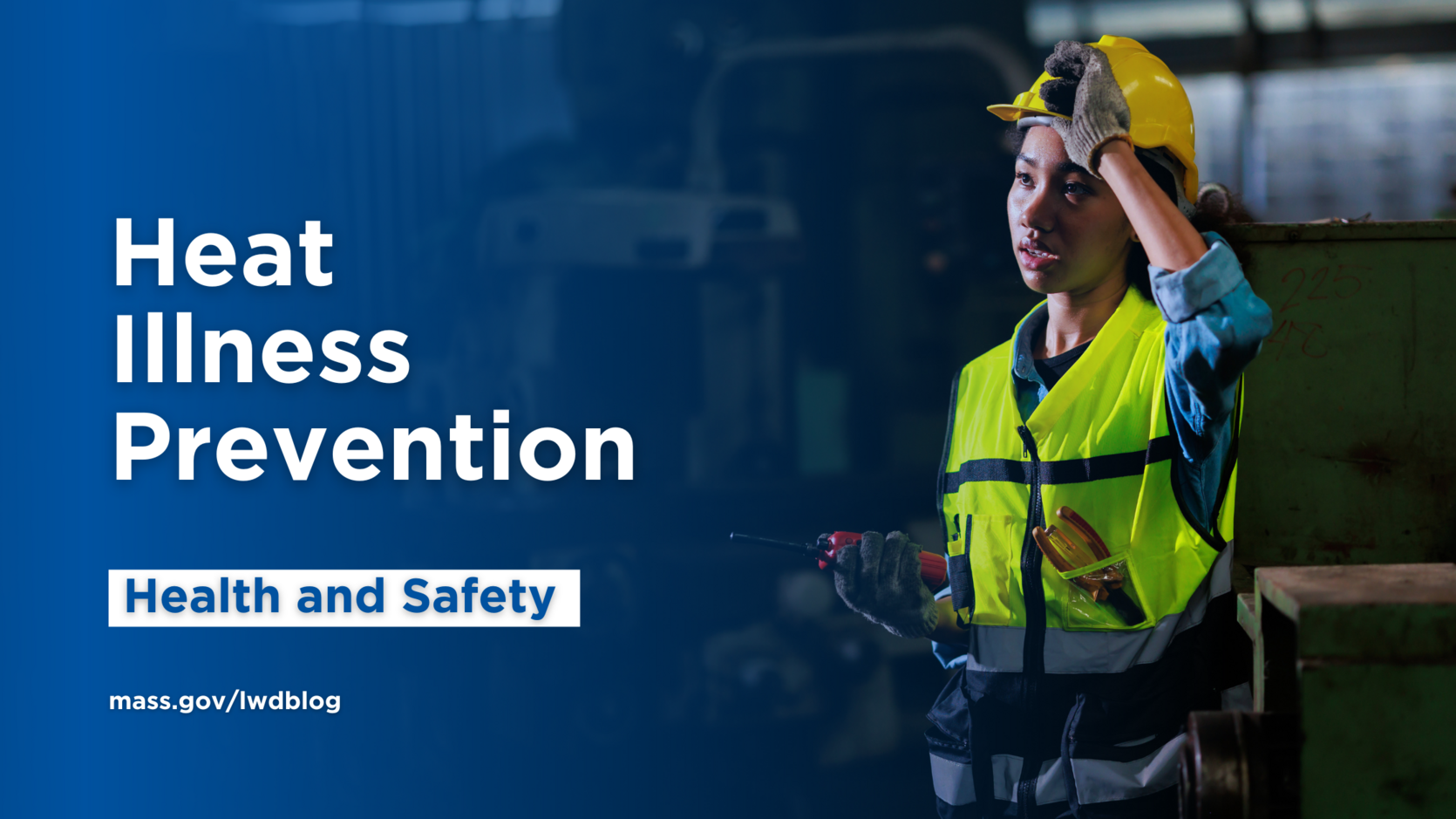- Executive Office of Labor and Workforce Development

Did you know? Between 2011 – 2019, the U.S. Bureau of Labor Statistics reported exposure to heat led to 43 work-related deaths and 2,410 injuries and illnesses.
Working in hot conditions isn’t just difficult—it’s dangerous. As temperatures rise, so does the risk of heat illness. On Heat Illness Awareness Day (Friday, May 26, 2023), the Executive Office of Labor and Workforce Development (EOLWD) and the Department of Labor Standards (DLS) remind employers and workers to be mindful and on the lookout for signs of heat illness.
Heat Exhaustion vs Heat Stroke. What’s the Difference?
According to the Center for Disease Control and Prevention (CDC), heat exhaustion is a mild heat-related illness that occurs in hot temperatures and when you do not drink enough water, whereas heat strokes occur when the body’s temperature rises quickly and cannot cool itself down.
Symptoms of heat exhaustion include:
- excessive thirst
- profuse sweating
- headache
- dizziness or confusion
- nausea
Early symptoms of heat stroke are similar to those of heat exhaustion but lead to more severe symptoms including:
- Lack of sweating
- Body temperature rising to 106°F or higher within 10-15 minutes
- Loss of consciousness
Employers and workers should become familiar with the symptoms of heat illness. When any of these symptoms are present, seek medical attention.
The Employer's Role in Preventing Heat Illness
- Provide one (1) quart of water to workers per hour.
-
Require frequent breaks to cool down in shaded areas or air-conditioned space.
- Build workers’ heat tolerance by gradually increasing workloads and allowing frequent breaks for new workers and those returning after a week or more off.
- Train workers to recognize symptoms of heat illness, what to do when they occur, and when to call 9-1-1.
The Worker’s Role in Preventing Heat Illness
- Stay hydrated and drink cool water, five (5) to seven (7) ounces every 15 to 20 minutes.
- Dress for the heat and wear a hat, light-colored, loose fitting, and breathable clothing.
- Take rest breaks and recover from the heat given the temperature and humidity.
- Work together and monitor yourself and others for signs of heat illness.
Remember these words “Water. Rest. Shade.”
You can find additional resources here:
OSHA: Heat Illness Prevention
DLS: MASSsafetyWorks! resources
DIA: The Workplace Safety Grant
¿Sabía que? Entre los años 2011 y 2019, la Oficina de Estadísticas Laborales de EE. UU. informó que la exposición al calor provocó 43 muertes relacionadas con el trabajo y 2410 lesiones y enfermedades.
Trabajar en condiciones de mucho calor no solo es difícil, es peligroso. A medida que aumentan las temperaturas, también lo hace el riesgo de sufrir enfermedades causadas por el calor. En el Día de Concientización sobre las Enfermedades causadas por el Calor (viernes 26 de mayo de 2023), la Oficina Ejecutiva de Trabajo y Desarrollo Laboral (EOLWD) y el Departamento de Normas Laborales (DLS) recuerdan a los empleadores y trabajadores que estén atentos a las señales de enfermedades causadas por el calor.
Agotamiento por calor vs golpe de calor. ¿Cuál es la diferencia?
Según el Centro para el Control y la Prevención de Enfermedades (CDC), el agotamiento por el calor es una enfermedad leve relacionada con el calor que ocurre en temperaturas altas y cuando no bebe suficiente agua, mientras que los golpes de calor ocurren cuando la temperatura del cuerpo aumenta rápidamente y no puede enfriarse por sí misma.
Los síntomas del agotamiento por calor incluyen:
- Excesiva sed
- abundante sudor
- dolor de cabeza
- mareos o confusión
- náuseas
Los primeros síntomas del golpe de calor son similares a los del agotamiento por calor, pero conducen a síntomas más graves que incluyen:
- Falta de sudor
- Temperatura corporal que sube a 106°F o más en 10-15 minutos
- Pérdida de consciencia
Los empleadores y trabajadores deben familiarizarse con los síntomas de las enfermedades causadas por el calor. Cuando cualquiera de estos síntomas esté presente, busque atención médica.
El papel del empleador en la prevención de enfermedades causadas por el calor
-
Proporcionar un (1) cuarto de galón de agua a los trabajadores por hora.
-
Requerir descansos frecuentes para refrescarse en áreas sombreadas o espacios con aire acondicionado.
- Observe la tolerancia al calor de los trabajadores aumentando progresivamente las cargas de trabajo y permitiendo descansos frecuentes para los trabajadores nuevos y aquellos que regresan después de una semana o más de descanso.
- Informe a los trabajadores para que reconozcan los síntomas de las enfermedades causadas por el calor, qué hacer cuando ocurran y cuándo llamar al 9-1-1.
El papel del trabajador en la prevención de las enfermedades causadas por el calor
- Manténgase hidratado y beba agua fresca, cinco (5) a siete (7) onzas cada 15 a 20 minutos.
- Vístase para soportar el calor y use un sombrero, ropa de colores claros, ropa suelta y transpirable.
- Hacer pausas para descansar y recuperarse del calor dada la temperatura y la humedad.
- Trabajen en equipo y obsérvense a sí mismos y a los demás para poder detectar signos de enfermedad por calor.
Recuerde estas palabras “Agua. Descansar. Sombra.”
Puede encontrar recursos adicionales aquí:
OSHA: Prevención de enfermedades causadas por el calor
